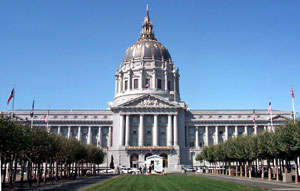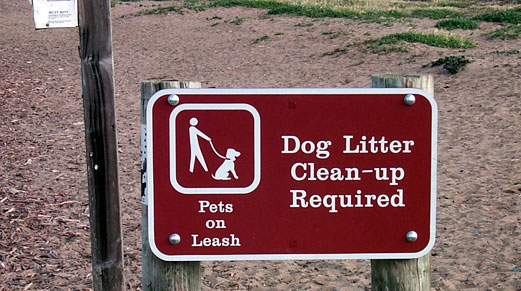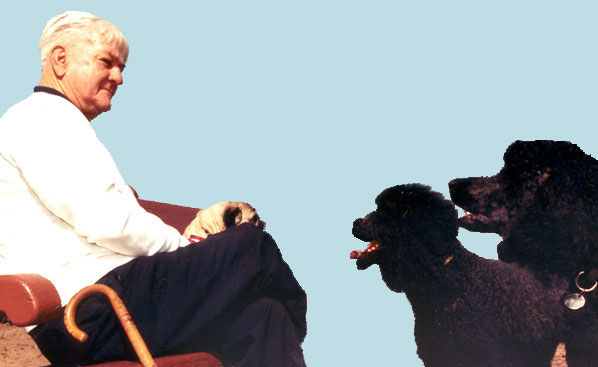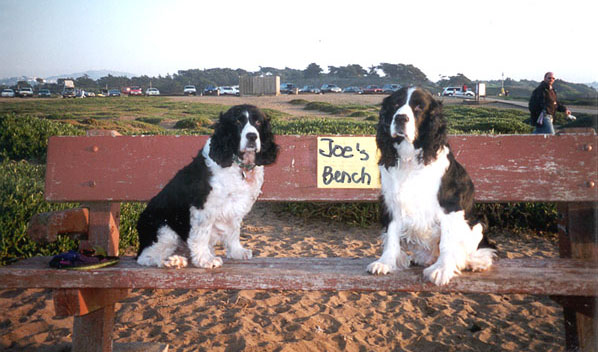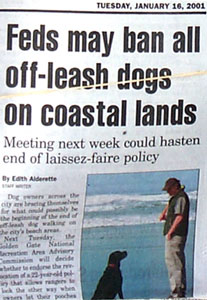|
GGNRA WatchDog
|
Second
Section
|
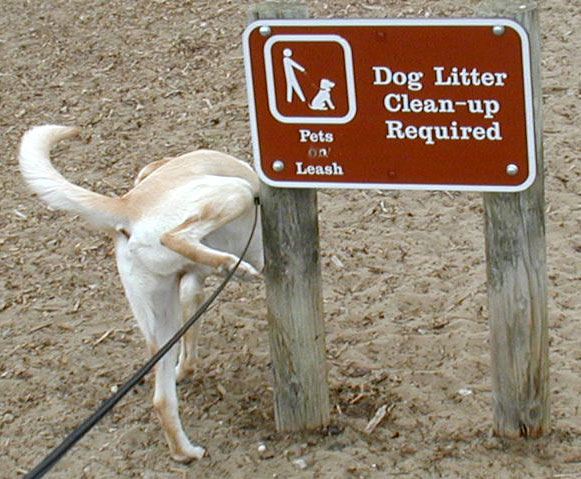
"Those park visitors who choose to violate the leash regulation are subject to warnings and citations."
Well, so much for the stock response about how it's up to the discretion of the individual officer. What started out as a conciliatory approach (albeit due to a thousand angry citizens and their supervisors refusing to accept rescission of the 1979 Pet Policy) and wandered through bureaucratic jargon now has this clear challenge, stated at the end of a May 22nd "ANPR Update" on the GGNRA's website:
ANPR UPDATEThis update is the 2nd in a series of public information reports on the ANPR process. Overview ANPR Status ANPR Project Manager Public Involvement Independent Consensus Building Group Community Relations Education on Leash Regulation |
|
The following postcard was received in early May by those on the Advisory Commission mailing list: ATTENTION PET OWNERS: REPORT ON ADVANCED NOTICE OF PROPOSED RULEMAKING The GGNRA has received approval and started a process known as Advanced Notice of Proposed Rulemaking (ANPR). One of the primary uses of ANPR is to involve the interested public in a regulatory action at an early stage. The first steps of the process are to draft the ANPR and to have it reviewed in Washington, D.C. and approved for publication in the Federal Register. Then, public input is collected and evaluated. GGNRA is working on the draft and hopes to have it ready shortly. Golden Gate National Recreation Area, National Park Service A NOTE FROM THE ADVISORY COMMISSION Our May meeting, held at Point Reyes Station, dealt with Marin issues. The June meeting at Half Moon Bay will deal with San Mateo issues. The July meeting will be in San Francisco and will include a progress report on the rulemaking process for pets. As was stated at our January 23 public hearing at the Presidio, the 1979 Pet Policy recommendations made by this Commission are not applicable to the park. They are unenforceable, violate Federal regulations, and never became park regulations. GGNRA has started a process to see whether or not the existing nationwide regulation, which requires that all pets be on leash where pets are allowed in national parks, can be adapted somewhat to the conditions of this park. The ANPR process will allow for public input on all sides of the issue. We anticipate multiple opportunities for your input during upcoming months. This notice, addressed to you, means that you are on our mailing list and will be notified of the dates and locations of future meetings. Richard Bartke, Chairman *** on other side, dated May 7, 2001 - NOTICE OF CANCELLATION The Golden Gate National Recreation Area and Point Reyes National
Seashore Advisory Commission meeting scheduled for Tuesday,
May 22, 2001 at GGNRA Park Headquarters, Bldg. 201, Fort Mason,
San Francisco has been CANCELLED. You will be notified of the
agenda and location for the next public meeting of the Advisory
Commission scheduled to be held in San Mateo County on June
26. |
State Senator Jackie
Speier's Letter to Brian O'Neill
|
|
Happy Dogs at
Crissy Field Celebration
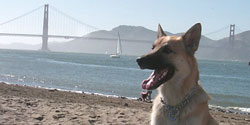
click here for photos!
|
click
here City and County of San Francisco |
But, You Promised!"We want to state clearly that we have no intent to eliminate . . . off-leash dog walking,'' O'Neill said. "All plans either maintain or expand off-leash dog walking. Under any future scenario, more generous areas of the Presidio's northern waterfront will be available to dogs.'' -
click
here to read this interesting and brief
article from 1995 |
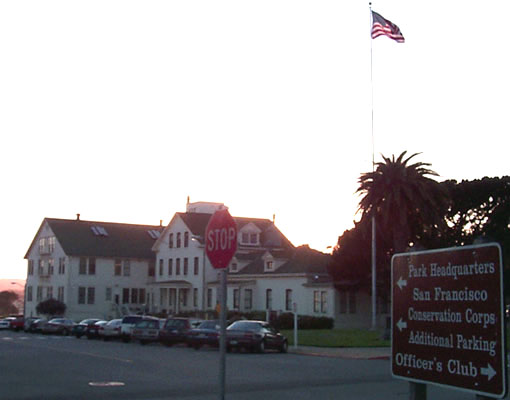 |
|
|
Transcript of the off-leash
issue discussion under Non-Agenda Items
at the GGNRA Advisory Commission Tuesday night, April 24, 2001. |
|
|
At the January 23, 2001 Advisory Commission meeting, there were around
1,000 more individuals who wished to speak, but Chairman Bartke persuaded
the people to postpone their opportunity to speak based on the suggestion
that there would be no changes in the interim while the matter was
being studied.
Mr. Bartke's proposal was that the public should let him curtail the right to public comment that night based on assurances of good faith that the GGNRA would not take action in the interim while studying the proposed change to the policy.
Here's the quote of a key point in the 1/23 meeting transcript where Mr. Bartke specifically suggests there will be no changes to signs in the interim:
CHAIRMAN BARTKE: I know. But whereas the Commission doesn't have to obey the rules, the park staff does. We will ask that the -- maybe this is implicit in the suggestion I made, not to be explicit, is that we ask that the staff not take any precipitous action to do anything until it's done these things within the next 120 days.
MS. VITTORI: So you're going to ask the staff to hold off to do anything
--
CHAIRMAN BARTKE: Hold off signs, citations, and so forth, until they
come back with a plan.
MS. VITTORI: Thank you very much.
[Applause.]
The Spin Goes On!
NEW! Letter from GGNRA Advisory Commissioners Bartke & Meyer
"Spin: 7. To provide an interpretation
(of a statement or event, for example), especially in a way meant
to sway public opinion."
- The American Heritage Dictionary, Fourth Edition
The 1979 Pet Policy was the guiding principle for off-leash dog walking for decades in the GGNRA. Suddenly and improperly, Amy Meyer presented a motion to drop it at the Advisory Commission's November meeting without the item even being on the agenda. After objections from members of both the audience and the commission, Richard Bartke ruled the motion out of order:
Amy
Meyer:
Richard
Bartke:
======== after some discussion and audience objections ========
Richard
Bartke:
So, the leash policy rescission went on the agenda for the next meeting, January 23rd. And an unprecedented groundswell of opposition was galvanized. Over a thousand citizens showed up at a meeting room that was way too small for the audience. Hundreds were barred by police from even entering the building, left out in the rainy night without even the courtesy of a loudspeaker to hear the proceedings. Almost all of the San Francisco Supervisors spoke, and threatened to take back the lands given to the Park Service in the seventies on the condition that existing uses such as off-leash dog walking must continue -- if the policy was rescinded.
So, the commission did not vote to rescind its policy because of this opposition. And they passed a resolution with a section calling for no changes for 120 days. Now with a lot of fanfare and press releases, the Park Service has announced a complex path called "Advanced Notice of Proposed Rulemaking", which isn't even rulemaking itself. With rulemaking it would be years before a result... and in the meantime, signs stating that leashes are required are going up. And the new letter claims that the policy was no longer in force, anyway... so why was it on the agenda in the first place?
NEW! Letter
from GGNRA Advisory Commissioners Bartke & Meyer
(or just read it below, instead)
Undated but posted on GGNRA's website around April 20... Not addressed to any particular "Editor", this letter is a link from Advisory Commission and Press Release/Public Affairs sections of website... One link says, "Attention Dog Owners from the GGNRA Advisory Commission" but doesn't indicate if, when or where the commission discussed or approved this letter.
The letter reads as follows:
|
LETTER TO THE EDITOR Editor -- We are writing to clear up a misunderstanding about off-leash dogs in Golden Gate National Recreation Area. The GGNRA Advisory Commission made several recommendations to Superintendent Brian O'Neill at our January 23 meeting. We asked him to meet with dog owners and with other interested parties. He has. We asked him to meet with other public land managers. A summit is getting underway. Our major request was that he try to find a way for our park to get an exception to the national regulation that all dogs be on-leash in national parks. He has done this by starting the process, awkwardly named "Advanced Notice of Proposed Rulemaking," so that managers of this national park can attempt to craft a different legal dog management policy. We did tell the audience a number of times at the January meeting that the Commission's 1978 policy recommendation permitting off-leash dogs in some places had been declared invalid and was no longer in force. The room was too noisy for this point to be heard. Instead, there is community perception that we will revisit dog issues at our May meeting; we will not because the rulemaking process has begun. New park signs state the standard national park dog leash requirement, which will be in place until -- and if -- the new rulemaking is successfully completed. We would like to have a win/win situation for all park users. We hope that many people with various opinions will participate in the rulemaking process. Richard Bartke, Chair |
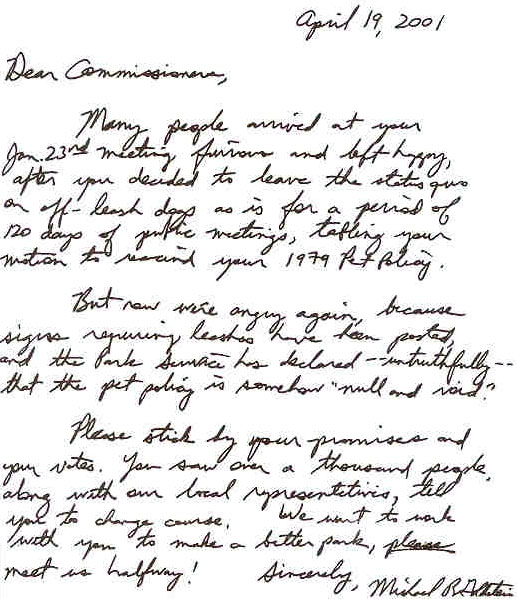
Attend the GGNRA Advisory Commission meeting
Tue. Apr. 24, 7:30 p.m. Bldg. 201, Fort Mason
More than a thousand citizens and almost the entire San Francisco Board of Supervisors came to a cold, rainy, hard-to-find January 23rd meeting of the Golden Gate National Recreation Area Advisory Commission, which was to vote on whether to rescind its 1979 Pet Policy. After hearing from fewer than fifty of those who tried to speak, the commission cut off further speakers.
The only reason the audience accepted being denied the right to speak was the commission's decision to table the motion for a 120 day period, during which there were explicitly to be no changes in policy or enforcement so that a good faith effort to engage in dialog with park users could begin.
Instead, while announcing a complex and time consuming process known as Advanced Notice of Proposed Rulemaking in the media, the National Park Service made immediate changes on the ground, posting new signs which state "Pets on Leash".
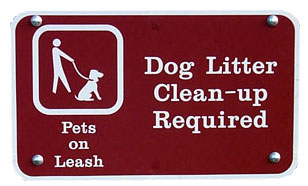
This can do nothing but create confusion, resentment and conflict. What's more, rather than acknowledge the fact that the commission tabled a vote on the Pet Policy, the spin was put out in subsequent days that the policy was just "null and void" and that the issue would actually not be returning to the commission at all -- NOT!
The Commission meeting:
|
Tuesday, April 24th Building 201 see map |
Although there are several other, possibly lengthy items on the agenda, citizens are free to speak at the end of the meeting under "Non-Agenda Items" after signing up at the start of the meeting.
Whether or not you attend the meeting, you can write to the commission, care of its chair, Rich Bartke, asking that they stand by their proposal of no changes in the leash policy at this time:
|
Mr.
Richard Bartke, Chair |
If you do write, mail your letter TODAY so that it will get into the commissioners' hands before the meeting!
click here for Earth Day 2000 Editorial -- same old story.
But here's good news: visit Green Friends !
Sign the Marin Open Space online petition! |
|||
|
|
Feb. 8 Editorial |
||

State Parks Off-Leash Study Bill by Sen. Jackie Speier
SB712 went before committee on Tuesday, April 24th, in Sacramento.
Please sign an online petition to support Senate Bill 712, Jackie Speier's proposed legislation for the State Department of Parks and Recreation to conduct a feasibility study regarding state park locations and conditions that would support off-leash dog activity.
http://www.PetitionOnline.com/JSSB712/petition.html
Send email, fax or letters of support to the Natural Resources and Wildlife committee chair (Sheila Kuehl c/o committee consultant Patricia Hanson), with a copy to Jackie Speier. Put "support SB712" in the subject line.
We need to counter the concern that opening up off-leash areas will cause harm to the parks. Some ideas for your letters:
| Your concern and sensitivity for environmental issues Loss of many other off-leash areas Historical off-leash areas are lost when land is given to State Parks (i.e. San Mateo beaches) | |
| The importance of off-leash recreation for both you and your dogs | |
| What you do to insure a pleasant visit for all visitors to existing off-leash areas |
Mailing address: State Capitol,Room# (see below), Sacramento,CA
95814
Sheila Kuehl (write her c/o: patricia.hanson@sen.ca.gov)
Room 4032 Fax 916-324-4823
Jackie Speier (senator.speier@sen.ca.gov)
Room 2032 Fax 916-327-2186

Did you miss The Independent article, "Protesters
gather at Fort Funston fences" on April 10?
Click here
for the article, reprinted with permission of The Independent
and author Edith Alderette.
Appeal to Gale Norton, Secretary of the Interior
Here's the text of the postcard people have been sending
to Gale Norton recently.
If you haven't already sent one, click
here, print it as a letter, and mail it today!
|
The Honorable Gale
Norton, Secretary of the Interior Dear Ms Norton, I am writing to request your immediate help to preserve off-leash dog walking in the Golden Gate National Recreation Area (GGNRA), a unit of the National Park Service (NPS) in the Bay Area. Off-leash dog walking was recognized as a legitimate form of recreation on GGNRA lands when the parks were transferred from local to federal jurisdiction in the mid-1970s. Today, tens of thousands of people enjoy this form in recreation in these parks. After extensive public review, several areas were designated as official off-leash recreational parks in a 1979 Pet Policy. Your office has already received over 17,000 petitions protesting closures for several of these areas in 1996 and 1999. We ask your support for a Section 7 rule as provided by 36 CFR 1.2(c) which will formalize the 1979 Pet Policy and restore access to the areas closed in San Francisco and Marin counties. I deeply appreciate your immediate attention to this matter. _________________________ print name _________________________ |
Point Isabel Dog Owners & Friends website
SIGN
THE PETITION
TO KEEP POINT ISABEL AND BATTERY POINT OFF-LEASH
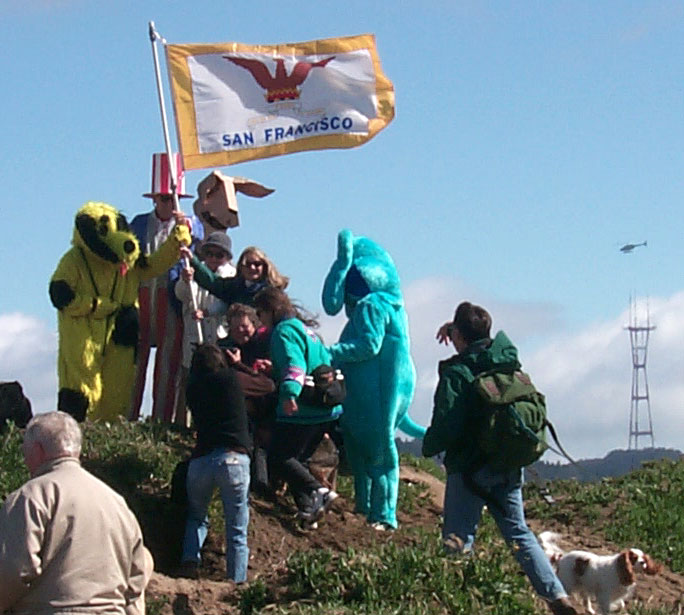
Protest Attended by Hundreds!
Click here to view an album of thirty photos from the April 7th demonstration.
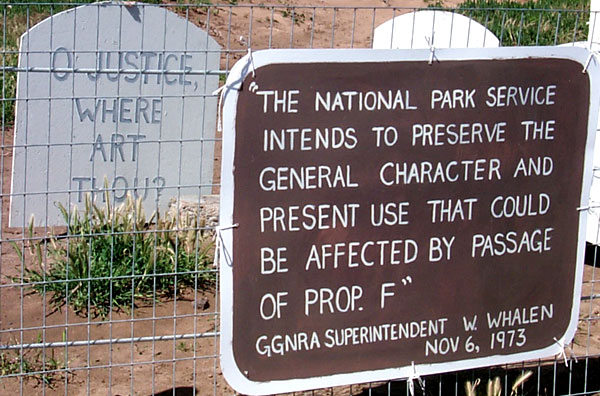
History Lesson
Push has come to shove, folks! Do you remember the bumper sticker: "If you're not mad, you're not paying attention!"?
Early last year, the National Park Service (NPS)
illegally closed ten acres at Fort Funston without input. We took
them to court and they suffered a huge embarrassment and were dealt
a federal injunction forcing them to re-open the area, after very
damaging documents from the case's discovery phase showed the extent
of the Park Service's efforts to sneak around the dog walking community:
www.fortfunstonforum.com/findings.htm
So they went through a complete sham of notice-and-comment,
receiving 1100 comments and detailed factual responses opposing their
plans. In spite of no valid science and no open public policy debate
about the merits of converting a recreation area into a preserve,
they blew it off, plain and simple. It was just the latest of a series
of actions, Closure Creep:
www.fortfunstonforum.com/closurecreep.htm
Meanwhile, in May last year they removed the "voice
control" signs at Fort Funston:
www.fortfunstonforum.com/offleashoffsigns.htm
Then in July, they removed those signs at Crissy
Field:
www.fortfunstonforum.com/crissyheeled.htm
In November, without even having it on their agenda,
the Advisory Commission was presented with a stealth motion to rescind
their quarter-century old leash policy. After objections they had
to admit this was out of order, and then were unable to rescind the
policy in January due to a thousand angry citizens and almost all
the supervisors objecting:
www.fortfunstonforum.com/advisorycommission.2001.01.23.htm
So, the NPS a few days later tried to sidestep this by falsely claiming the policy was null and void.
Then, they changed the signs at Ocean Beach to deceive
people there about a longstanding compromise as to where off-leash
walking was OK:
www.fortfunstonforum.com/oceanbeach.htm
Off-leash recreation was promised to be continued
when they took our beaches in the seventies, and it was promised to
continue when they raised money for the Crissy Field project which
they are planning to crown with a big shindig in one month:
http://www.crissyfield.org
Now, they have planted the first new leash-required
sign, on the chipped trail at Fort Funston, while crowing to the media
that they are taking the lead on dogwalking in the Bay Area:
(see below)
They need to know that they need to keep their promises.
We cannot afford to be marginalized with these new signs, and
no explanation that has been put forth is acceptable.
- Michael B. Goldstein, Editor
|
"GGNRA is trying to do by fiat what it has learned it probably could not get away with if it fairly engaged in the public comment and rulemaking oversight process"April 4, 2001 Mr. Brian O'Neill Re: Recent Sign Changes Concerning Off Leash Dog Walking Recreation Dear Superintendent O'Neill: I understand that the Park Service is again changing signs such as to significantly restrict traditional off leash dog walking recreation. The new changes result in an activity restriction which is of a nature, magnitude and duration that will result in a significant alteration in the public use pattern of the park area, and is highly controversial. Yet there appears to have been no compliance with the notice-and-comment rulemaking procedures contemplated by 36 C.F.R. 1.5(b). See Ft. Funston Dog Walkers v. Babbitt, 96 F. Supp 2d 1021 (2000). Specifically, the Park Service recently removed the prior signs at Ocean Beach. The prior signs had clearly set forth and distinguished the portions of Ocean Beach where off leash dog walking recreational activity is tolerated from the restricted portions of the beach. The Park replaced those clear signs with unclear signs that eliminate the distinction between the restricted as opposed to unrestricted portions of the beach, and newly suggest that off lead dog walking is not allowed at all. That would be a substantial change to the historical recreation use pattern at Ocean Beach. The prior signs had reflected the result of substantial public debate, including ten thousand petition signatures objecting when the GGNRA staff previously suggested the closure. The prior signs also were consistent with the long term GGNRA policy concerning Ocean Beach while the current are not. There can be no dispute that it would be highly controversial and would be a significant alteration of the public use pattern to embark on such changes to the previously allowed and very popular off leash recreation use of Ocean Beach. Additionally, your recent press release suggests that similar new signs will be installed at other areas of the GGNRA where off leash dog walking previously has been widely enjoyed . As you are well aware, such changes are highly controversial, and would significantly alter the predominate recreational use activity of certain areas of the National Recreation Area. When the GGNRA tried to make such changes in January, thousands showed up at the public hearing. The Advisory Commission cut the hearing short before hearing from most of the people signed up to speak. The public allowed that to happen based on the representation made that "no action" would be taken on the proposal to eliminate the prior policy. The clear intent expressed by the Advisory Commission was that there would be no changes to off leash recreation in the 120 day interim while the GGNRA staff was to begin to investigate and have discussions on how to resolve the controversial issue. You are well aware that the public comment presented on the earlier related restriction proposals clearly reflects that the park user community is overwhelmingly opposed and profoundly upset by the GGNRA campaign to further restrict recreational dog walking. Even the City of San Francisco has intervened to demand that you engage in careful public policy analysis and discussions before embarking on such changes that would so affect the quality of life of so many. Yet it now appears that the GGNRA is trying to do by fiat what it has learned it probably could not get away with if it fairly engaged in the public comment and rulemaking oversight process. Please exercise great care to comply with the requirements of public input. High respect for that democratic process might assist you in avoiding the peril of again igniting a firestorm of controversy over perceived inappropriate and arbitrary action. Sincerely, John B. Keating |
||||
New Sign Up Already at Fort Funston!
|
||||
|
||||
|
||||
|
Superintendent Explains Off-Leash
Rulemaking Option Brian O'Neill, in his Superintendent's Report at the GGNRA Advisory Commission's March 27th meeting, announced that he has received approval from Washington to go forward with what is known as "Advanced Notice of Proposed Rulemaking" (ANPR) on the issue of off-leash recreation. While saying that it is not clear whether formal rulemaking would be desirable and that the process is new to the GGNRA, he pointed out that this method is not prescriptive in that it doesn't tell the GGNRA what to do ultimately. The ANPR process would seek to determine first, "whether the community in its collective voice feels we should be enforcing the leash regulation or that there's a way to... designate areas that would be available" by days of week, area, hours of the day, etc., said O'Neill. "We will increase our communication with all stakeholder groups and the general public," O'Neill claimed, saying that the process "will assure that all voices are heard in a non-threatening environment." The process had been announced at a press conference on March 21st (see news release, below). One option under consideration is to hire a professional outside firm to facilitate the process. The ANPR process is designed to determine, according to the Superintendent, "if it's the will of the community and the National Park Service to go through a more structured rulemaking process." Amy Meyer, Vice Chair of the commission and chairing the meeting during Chair Rich Bartke's absence, said that the leash issue would not be returning to the commission and that the 120 day period announced at the last meeting therefore was not in effect. It's not clear what all this means for the future. As the process unfolds, look to this website for ongoing news and analysis. - Michael B. Goldstein, Editor |
Ocean Beach Signs Deliberately Misleading?
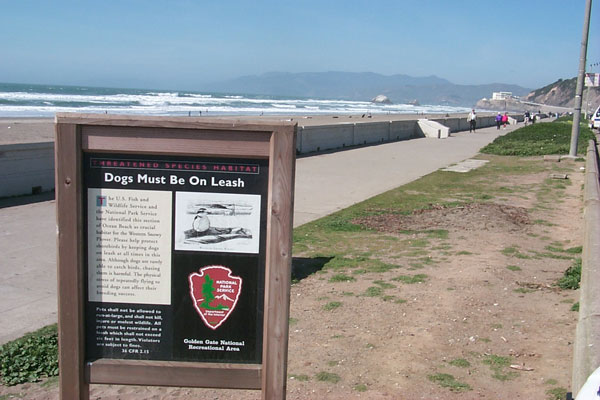
This sign at Stairwell 21 on Ocean Beach gives the false impression that dogs must be on-leash when in fact they are allowed off-leash in the entire (North of Stairwell 21) beach in view here.
Click here for more Ocean Beach photos and story!
|
| March 21, 2001: | |||
Acting on a January recommendation from the Golden Gate National Recreation Area (GGNRA) Citizens Advisory Commission, the National Park Service (NPS) announced today it will take a leadership role in involving the public in a review of dog leash policies in the GGNRA. The process, called Advance Notice of Proposed Rulemaking (ANPR), has been successfully used to resolve controversies in other agencies. Once our research identified the ANPR option, we sought and received endorsement by NPS headquarters in Washington for its use in the GGNRA. The ANPR, though detailed, basically outlines different avenues that can be used by the NPS and the public to identify and address controversial park issues. The process involves several steps: publicizing an ANPR, collecting public input through a Federal Register Notice, evaluating that input and determining if there is a need to revise the present regulation requiring dogs on leash. If the need for a revised regulation is established, the park will then engage in a rulemaking process beginning with a notice in the Federal Register of proposed rulemaking seeking further public comment. "There is a real need for this process," said GGNRA Superintendent Brian O’Neill. "The dogwalking issue has caused heated debate in the Bay Area as well as growing visitor use conflicts in national, state and local parks. The ANPR is a creative opportunity for us to take the lead, bring all the ideas to the table and find a solution that is acceptable to the public at large and consistent with the Park Service mission." O’Neill said he and local NPS staff will immediately begin taking the next step of providing ANPR briefings to interested groups including the Bay Area Congressional delegation, state and local government officials, the GGNRA Citizens Advisory Commission, and dogwalking, environmental and other interest groups. "We want the word out that there is a solution-oriented process and someone willing to lead it," O’Neill explained. O’Neill stressed that the local NPS office is not taking a position on what, if any, revision should be made in the existing dogwalking regulation. "That’s for the process to decide," he said. "The ANPR process is a clean slate. It allows us to put conflict behind us, invite everyone to the table and open-mindedly pursue a long-term solution. Let us prove we are the region that knows how."
The National
Park Service announced today that it would prepare an Advanced Notice
of Proposed Rulemaking concerning dog management in the Golden Gate
National Parks. The Advanced Notice, which could lead to adoption
of new regulations, will solicit public comment on a range of potential
management options for accommodating appropriate dog walking in
the Golden Gate National Parks, consistent with protecting national
park resources and assuring visitor safety. Recognizing the regional
nature of the issues, the National Park Service looks forward to
working with local partners to develop a park approach that would
fit into a regional solution. Several recent events in the region
have underscored the need for undertaking this public process, including
litigation concerning the Fort Funston area of the park, public
concern about visitor and pet safety, park resource management issues
involving wildlife and vegetation protection, and the review of
dog-walking issues by the Golden Gate National Recreation Area Advisory
Commission. These events has also prompted the National Park Service
to review the currently
Environmental Groups: National
Parks and Conservation Association Dog Walking Groups: San Francisco
SPCA Congressional Offices: Office
of Congresswoman Pelosi |
|
3/19/01 INTRODUCTION FORM Sponsor(s): Supervisor Leland Yee The 1975 Agreement established the Golden Gate National Recreation Area and contains the responsibilities of the GGNRA in administering oversight of the land. Although the operating responsibilities are clear to the City, there seems to be disagreement as to some of the responsibilities on the part of the GGNRA. The amendment should specify that the GGNRA must consult the City in the areas of planning, land use planning and regulation of recreational use. The City should be consulted about any changes on the land or changes in use on the land. The language should also reflect that changes include fence construction, closing off any portions of the land to any kind of recreational use, any changes on the allowance or disallowance of any sort of recreational use, and any changes in policy which affect San Franciscans who use the land for recreation. The amending language should expand notification to include the Board of Supervisors and reflect that consultation should occur at the earliest possible stage in the planning process and should allow for the City to hold an appropriately noticed public hearing if necessary. Failure of the GGNRA to reach agreement on this issue
will result in the City initiating an action seeking reversion of
the property to City. |
| Leland_Yee@ci.sf.ca.us |
|
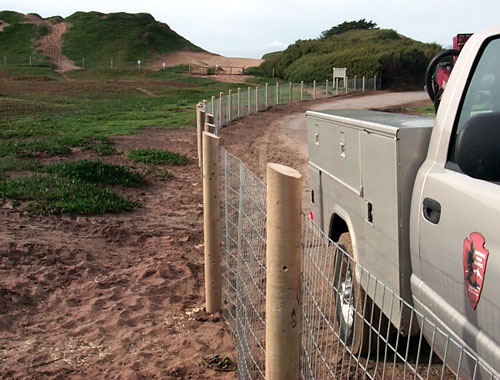
|
National Park Service employees in late February 2001
installed new fences around the two-payback-acres;
payback because the Park Service decided they "needed" to
also close these two acres, only after they'd lost in federal court
over their illegal closure of ten acres (in background). Now will
the iceplant be ripped out as "non-native", causing huge
sandstorms to blow in the faces of people walking along the road?
These two acres are nowhere near the bank swallow cliff burrows, this
is merely the latest Closure Creep Land Grab,
in which parcels of land are taken out of recreational use one-by-one
so that the overall mandate of the GGNRA to "provide for needed
urban recreation" is violated piecemeal without any public
input on such a huge policy change. Sadly, the Park Service uses unproven
claims of protecting the environment as a cover for these actions.
Remember, though: the Park Service employees erecting fences aren't the ones who made these decisions, so be respectful. Write their boss's boss's new boss, Interior Secretary Gale Norton and urge her to take a close look at how the GGNRA management has ignored the will of the entire San Francisco Board of Supervisors and thousands of park users, fencing us out of our own park for no valid reason.. |
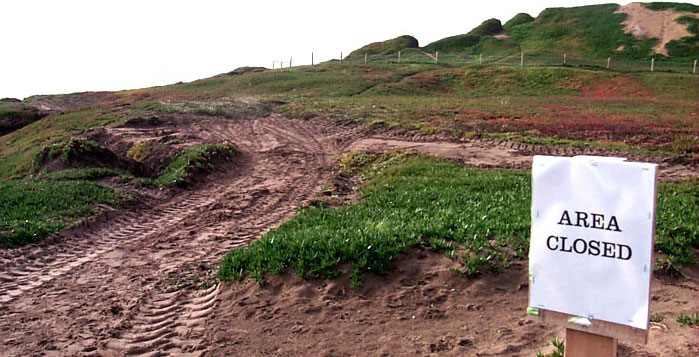
|
With this field closed, beachgoers
will all be forced down one narrow, fenced-in "Beach Access"
chute.
|
|
|
|
Lydia Boesch's Letter
to SF City Attorney Louise Renne
|
|
Correspondence between GGNRA
& City of San Francisco (City Attorney & Supervisors)
|
|
Excerpts From Interior Secretary Gale
Norton's Confirmation Hearings:
"We plan to return scientists to our parks...", and, "... I am firmly committed to a process of consultation and collaboration. We should listen to all voices and involve all citizens. That is fair. It is also wise. People are a magnificent resource for ideas, for knowledge, for insights. I've lived and worked here in Washington. I have also lived and worked in the great American West. Those of us here in Washington need to be good partners with Americans living in other parts of this country and in our territories. America is a stronger nation because of the diversity of its people. These people hold many different views and perspectives. We need to work with them, to involve them, to benefit from their creativity and their capacity to innovate." (emphasis added) |
Gates Locked to Fort Funston Closure Area in February
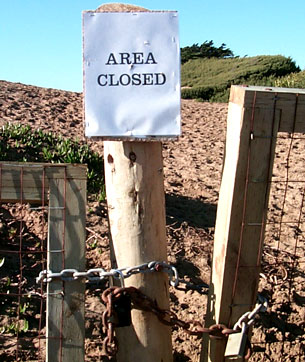
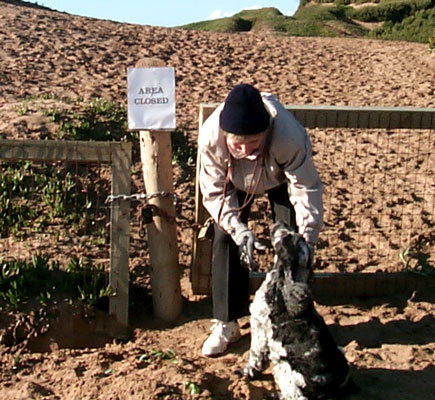
Breaking the news to Macarthur, whose owner has been walking
in the now-closed area for fifteen years.
ALLOWING FORT FUNSTON AREA CLOSURE:
FILED
01 FEB 13 AM 11:49
RICHARD W.
WIENING
CLERK, U.S. DISTRICT
COURT
NORTHERN DISTRICT OF CALIFORNIA
IN THE UNITED STATES DISTRICT COURT
|
No. C 00-00877 WHA |
|
FT.
FUNSTON DOG WALKERS, a |
Plaintiffs,
V.
|
ORDER VACATING |
|
BRUCE BABBITT, Secretary of the Interior; |
Defendants.
____________________________________/
GOLDEN GATE AUDUBON SOCIETY,
Intervener/Defendant.
____________________________________/
In
opposition to the application and motion to vacate, plaintiffs allude
to new theories and fresh violations of law.
None is properly before the Court. Despite conferences in which the subject
of possible amendments was discussed, plaintiffs have utterly failed to
amend their
pleadings or to advance, even if an amendment were before the Court. any
cognizable basis for
setting aside the new agency action taken in response to
the procedural criticism originally
leveled by plaintiffs themselves.
In short, plaintiffs wanted public hearings and comment. They got it.
The agency resolved the public policy debate. Plaintiffs may dislike the
substantive result, but the procedural infirmity was cured.
Plaintiffs
argue that the new agency action is based on bad science concerning the
best
way to protect the bank swallows when they
are seasonally at home in the Funston cliffs.
Perhaps. Perhaps not, That
is
exactly the kind of judgment call Congress delegated to the park
professionals.
No showing has been made that the agency's judgment and balance of competing
use
demands was arbitrary and capricious
within the meaning of the Administrative Procedure
Act, 5 U.S.C. 701-06, and/or unsupported by an administrative record,
a record not even before
the Court. So too with issues of safety and re-vegetation assigned by
plaintiffs as substantive
error. As for the new allegations of procedural error (e.g., late
release of environmental data and
failure to complete an environmental impact statement), they are brand
new charges. They are
not what
led to the preliminary injunction in the first place. They were not pled
in the complaint. If plaintiffs wish to file a new lawsuit and to prove
up new impoprieties, they are free to do so. The new accusations cannot,
however, be used to prolong an injunction premised on a wrong since cured.
Finally,
plaintiffs argue that
the new action is subject to a sixty-day stay pending administration review
issued by our new president for all pending regulations. There is an outside
chance that the new proposed closure
will be vetoed in this internal review process. That possibility poses
some uncertainty. In those circumstances, the Court cannot rule out the
possibility of some future agency detour that would warrant relief under
the original complaint herein, remote though that seems.
Meanwhile,
the park professionals seek relief from the injunction based on the expected
return of the bank swallows in March, possibly within two weeks, if history
is any guide. They wish to begin preparing the closure intended for the
swallows' protection, erecting fences, placing signs, and so forth. They
do not want to offend the preliminary injunction. The imminent return
of the swallows is a certainty. A veto by President Bush of the new closure
is not. The Court concludes that the defendants have now fully complied
with 36 C.F.R. 1.5,
that
the need for prompt protective action is genuine, and that the need overshadows
the small risk of rule veto.
The
preliminary injunction is VACATED without
prejudice to any new motion for
relief plaintiffs might bring in changed circumstances. At the hearing
on February 22, 2001, plaintiffs SHALL SHOW CAUSE why this action should
not be dismissed as moot. The application and motion to vacate the injunction,
having been resolved by this order, are taken off calendar.
-
IT
IS SO ORDERED.
Dated:
February 13, 2001.
WILLIAM ALSUP
UNITED STATES
DISTRICT JUDGE
Secretary of the Interior,
1849 “C” St.
Washington DC 20240
|
Write to Gale Norton! ...... Here are some points to make: * The decision-making process has shut out citizen participation. * The federal government has shut down traditional use, despite unanimous opposition from local government (San Francisco Board of Supervisors). * The Park Service is denying recreational access -- to all, not just people with dogs. * "Native plant" projects have destroyed ecology and impacted the threatenend Bank Swallow colony. * Kids can't play on the splendid sand dune that is known as "Joey's Hill". * Ugly fences have been erected all over, ignoring the Park Service's aesthetic mandate. Ask the Secretary to immediately halt and review the impending Fort Funston closure actions of the previous Administration. |
| Here's a sample letter to Gale Norton, to give you ideas for your own letter. |
| The Honorable Gale Norton Secretary of the Interior U.S. Department of the Interior 1849 C Street N.W. Washington, DC 20240 Dear Ms. Norton, I am writing to request your immediate intervention in two serious and time-sensitive issues regarding land use within the Golden Gate National Recreation Area (GGNRA), a unit of the National Park Service (NPS) in the San Francisco Bay Area. The first regards the closure of twelve acres of some of the most popular recreation areas at Fort Funston, a GGNRA park within the city of San Francisco. This closure was initially carried out by the NPS without the required public review period. This action resulted in a federal lawsuit. The U.S. District Court temporarily enjoined the closure, and the NPS subsequently solicited public input. Despite overwhelming citizen opposition, however, the entirety of public input was summarily dismissed and the size of the closure area was increased. The Court soon may lift the injunction. The second issue involves the recent NPS plan to ban all off-leash dog walking in all the parks making up the GGNRA, an activity enjoyed by tens of thousands of individuals on these lands for many decades. Because off-leash dog walking had been an important historical use of these lands, it was officially recognized as a legitimate form of recreation in these parks and was part of the agreement made to local communities when the lands were transferred to federal jurisdiction in the mid-1970’s. Without your intervention, the Superintendent of the GGNRA will permanently close the twelve acres to the public in late February when the injunction is lifted. He will likewise ignore the overwhelming amount of public input supporting off-leash dog walking and likely will take steps to ban off-leash dog walking in the entire GGNRA when the matter comes up for review in late May. The situation has become so serious, that the Board of Supervisors of the City of San Francisco unanimously voted to begin legal actions to take the parks back from the federal government should the NPS ignore public input, ignore its commitments to the City, and act to ban off-leash dog walking. There are ways that you can help: (1) Instruct the Superintendent of the GGNRA to put an immediate stop to the closures at Fort Funston so you can review the situation, and (2) support the local attempt to create a Special Section 7 rule permitting off-leash recreation in GGNRA parks. (Add your own sentiments here) I deeply appreciate your immediate attention to this matter. Sincerely, (Your Name) cc: The Honorable Louise Renne, Esq., San Francisco City Attorney |
| Another letter to Gale Norton, who was confirmed as Secretary of
the Interior by the Senate on January 29th. by Nathan Winograd. |
| January 24, 2000
The Honorable Gale Norton Dear Ms. Norton: Since 1992, the Interior Department has reversed longstanding cooperation between the federal government and the City and County of San Francisco over management of the Golden Gate National Recreation Area ("GGNRA"). In the process, the National Park Service ("NPS") has closed or limited recreation opportunities in over 50 acres of the GGNRA's most popular areas without public review and despite significant public outcry in order to create fenced native plant preserves. As these practices violate longstanding public use, historical cooperation, public participation rights, as well as impact quality of life issues for the citizens of the San Francisco Bay Area, we are appealing for your support. For over four decades, local citizens have enjoyed the breathtaking views, vistas, and trails of what is now the GGNRA. Prior to the creation of this great urban park, much of the lands belonged to the citizens of San Francisco. In the early 1970s, San Francisco voters were asked to give the NPS jurisdiction over these local parks. In return, the voters were promised that recreation opportunities would not be limited. In fact, the public was assured no one would even notice the change. To address concerns from city officials and citizens over the release of this land to the federal government, certain unique restrictions were inserted into the enabling statute. In particular, the GGNRA was established for "maintenance of needed recreational open space necessary to urban environment and planning." (16 U.S.C. Section 460bb.) Relying on this language and representations by officials that this was "a technical resolution" that would not affect "recreational use by all citizens," the people of San Francisco approved in 1973 a Charter Amendment, which permitted the transfer of these city parks to the federal government. One of the key activities that San Franciscans have enjoyed in these parks is off-leash dog walking. To address concerns that off-leash dog walking violated NPS regulations codified at 36 C.F.R. 2.15(a), yet was an important--indeed the primary--historical use of the area prior to the grant of land to the stewardship of the federal government, the NPS codified off-leash use in what has become known as the "1979 Pet Policy," finding that, "the ordinary guidelines outlined in the Code of Federal Regulations do not really apply in an urban area. People and their animals have been visiting the park for too long to apply an all-inclusive arbitrary policy." (Meyer, A., Chairperson, GGNRA Citizens Advisory Commission.) This policy of permitting dogs to run unimpeded with a leash is consistent with historical use, commitments made to the citizens of San Francisco who donated the land, the policy of the NPS that each park must be managed according to its unique cultural and geographical attributes, and with legislative history that created the park, as evident in the words of a seven-year-old San Francisco resident Elizabeth Linke: "Dear Congressman Ron Taylor: I want a park, so I can play in the park and my sister wants a park to and so my dog can play with another dog and my Mom wants a park so she could take my dog out to play. I hope you will make a park." (H.R. Rep. No. 1391, 92nd Cong., 2nd Session, at pp. 413-414.) And for almost two decades, the recreation needs for this area have by and large been honored, with wildlife and recreation coexisting peacefully. In 1992, however, that all changed. With the arrival of a new Administration in Washington D.C. and to oversee the transfer of the Presidio, under the control of the U.S.Army, to the NPS and incorporation into the GGNRA, the San Francisco Bay Area received an influx of literally hundreds of new NPS rangers with no ties to the local community. To remedy concerns by local citizens that the new Administration was intent on converting recreation space to so-called native plant preserves, we met with NPS staff. We were promised that the recreation activity we enjoyed prior to donating the land to the federal government (off-leash dog walking, sliding on the sand dunes, hiking, jogging) would not be limited, and that any changes would be subject to public review and comment. That promise would not be honored. Not only were efforts to formalize the 1979 Pet Policy through a Section 7 rule thwarted by the Interior Department under Secretary Bruce Babbitt, but the new Administration began creating these "native plant preserves" through a process of either closing access to people and their dogs and/or by erecting fences designed to keep all of the public out. Since their arrival, recreation opportunities in over 50 acres of the GGNRA's most popular areas have either been limited or completely closed, turning what was intended to be a recreation center into a fenced compound--off limits to all but the NPS staff assigned to keep the rest of us out. And, in the process, striking at the core of what the public values most about the park. In fact, the NPS conducted a study in 1999 of Fort Funston, a former San Francisco city park now part of the GGNRA. The study revealed that 74% of the public identified the ability to enjoy the park with their dogs off-leash as the most important aspect of the area. The second largest response, 21%, identified the area's breathtaking views and 17% said its beauty. The closures, marked by either fences throughout the GGNRA or park rangers criminalizing these activities through citations, not only keep our constituents from enjoying the area with their families and their dogs, but everyone--the children at play, the joggers, the hang gliders, the photographers, the tourists. Nor was the failure to uphold public promises and public review principles an isolated practice. As noted by one commentator in a November 6, 1997 San Francisco Chronicle article: 'Hikers and picnickers have found their favorite vistas, woods, and sand dunes roped off without notice, and many trees have been cut down to create pseudo-native habitats without public review.' Indeed, in response to a lawsuit by dog walkers for failure to hold public hearings prior to closing off public land, a U.S. District Judge ordered public notice and comment after finding an "intent on the part of the National Park Service to railroad through the closure, to maintain secrecy, to unleash the fencing with lightning speed, and to establish a fait accompli." (Fort Funston Dog Walkers v. Babbitt, No. C00-00877 WHA, Findings of Fact and Conclusions of Law, dated April 26, 2000, enclosed for your review.) This was consistent with previous actions: closures of recreation
space without public review in 1992, 1993, and 1995. Although the
closures have been driven by the desire to turn the GGNRA into a native
plant preserve, after the most recent controversy arose over the closures
in 2000, the justification shifted to protection of the bank swallow.
The NPS asserts, after-the-fact, that recreational activity and the
current, albeit classified as "exotic" ecosystem, is impacting
the bank swallow population within the GGNRA. This claim has no basis
in fact. Historical observations indicate that the bank swallow colony
has existed--and thrived--within the GGNRA since 1905 despite recreation
activity. In addition, the relative stability of the area's topography,
as well as Beginning in late 1991 and increasing precipitously in 1994, the NPS began destroying the local ecology without an environmental impact analysis and despite significant public outcry. Following the destruction, the stable and thriving bank swallow began to decline and continued to decline lockstep with increasing NPS destruction of the existing ecology until the bank swallow simply fled the so-called "Bank Swallow Protection Area" to the "exotic" ecology and adjacent to recreational activity of another area. This area is now subject to the same NPS activities (closure to public use, elimination of recreational activity, and destruction of the existing ecology) that decimated the original colony location. A thorough analysis is enclosed for your review. By order of the U.S. District Court which reversed the 2000 closure
until the NPS held public hearings, the NPS did hold public notice
and comment rulemaking--and, despite heavy citizen opposition, not
only tripled the size of the original permanent closure, it removed
all signs indicating areas were open to off-leash dog walking (voice
control), threatened to revoke the "1979 Pet Policy" despite
a total of over forty years of local practice, and signaled its intent
to close further areas from public use in order to create native plant
preserves. The NPS was also not shy about its actions: officials have
publicly admitted that this was "in response to the lawsuit,"
a case of clear retaliation This is an issue that goes beyond issues of dog walking and recreation. San Francisco is the most concentrated urban area in the United States outside of Manhattan. We live in apartments, condominiums, and row houses with "postage stamp"-sized backyards. The open space and recreation opportunities afforded by the GGNRA are critical to quality of life issues for citizens here. At the same time that NPS bureaucrats have limited or eliminated these opportunities, they have converted the Presidio into their own private estate, replete with large homes and apartments nestled among groves of stately trees, expansive lawns, and breath-taking views, all subsidized at below market rates at taxpayer expense. But neither the people of San Francisco when they donated their parks nor the Congress that created the GGNRA intended a private estate for NPS staff replete with native plant preserves. As evidenced by its name, the Golden Gate National Recreation Area is a recreation center, surrounded by a heavily populated urban environment. And it is the GGNRA's recreational value that was of the utmost importance to the Congress that established this great urban park. In their words, the GGNRA was to be a "new national urban recreation area which will concentrate on serving the outdoor needs of the people of this metropolitan region," and its objective was "to expand to the maximum extent possible the outdoor recreation opportunities available in this region." (H.R. Rep. 1391, 92nd Cong., 2nd Session (1972).) Ms. Norton, on March 18, 1998, before the U.S. House of Representatives Committee on Resources, you testified that "states have often found themselves at odds with the federal government when the issue involves public lands--an issue that is critically important to western states." (Norton, G., Attorney General of Colorado, Testimony before the U.S. House of Representatives, Committee on Resources, National Environmental Policy Act, 1998.) It is precisely this dilemma we face over use and enjoyment of the GGNRA. We think the question of whether the GGNRA is going to be a recreation area--nestled as it is on the edge of a major metropolitan area--or whether it is going to be a pristine national park inaccessible to the bulk of the individuals who use it now--needs to be answered. But we don't believe this question should be answered by NPS staff alone. Rather we ask that it be put to the public--to the hundreds of thousands of citizens who care deeply about the future of these spectacular lands. We believe this is in keeping with your belief that "[i]nnovative environmental policies, just like other innovative policies, come about when the states act as 'laboratories of democracy'..." (Id.) Finally, you indicated that, "[i]n addition to innovative policies, the states are important in the federal-state environmental partnership because there is no such thing as a one-size-fits-all government. The states, where government is closer to the people, are the proper entities to implement environmental laws and policies." (Id.) We agree. And it is precisely our contention that there is no such thing as a "one-size-fits-all" National Park. While we have been repeatedly told by NPS staff that the GGNRA will be run like any other national park regardless of historical use, urban or rural location, local culture, or the desires of local citizens, federal law offers a different framework: it is the legislative history and park-specific statute that ascertains the scope of permitted activities. While the NPS asserts that creating native plant habitats is within the NPS mission and requires the destruction of the existing GGNRA ecosystem and closures of recreational activities, the mission of the NPS within the GGNRA is, however, embodied in statute: the GGNRA was created to serve the recreational needs of an urban area. If native plants are not adapted to recreation areas, they should not be planted in an urban park. And while close to 17,000 individuals have asked that the NPS uphold
past promises and commitments to abide by the historical recreation
opportunities enjoyed by the citizens of the San Francisco Bay Area;
despite five unanimous resolutions by the San Francisco Board of Supervisors
asking the NPS to comply with agreements for local cooperation, requesting
delay so that the impact on local city parks could be properly analyzed,
and threatening to file suit to reacquire the donated parks for failure
to comply with the terms of the transfer; and despite numerous letters
from state and local leaders--"where Several organizations collectively representing over 100,000 individuals, including the Fort Funston Dog Walkers, San Francisco Dog Owners Group, Pt. Isabel Dog Owners, Crissy Field Dog Group, Palo Alto Humane Society, Palo Alto PUPS, and Peninsula Access for Dogs, among others, have united to oppose the closures. On their behalf, and on behalf of the 17,000 individuals who signed the enclosed petitions, we ask for the opportunity--consistent with legislative history, historical use, and the principles of citizen-government--to have a role in how the park is managed. We request an audience with you to discuss the future of the GGNRA. And we appeal for the opportunity to reimplement the 'laboratory of democracy' we enjoyed in our federal-state-local partnership that allowed recreation and wildlife to peacefully coexist for decades, prior to the policy shift implemented in 1992. Very truly yours, Nathan J. Winograd |
CLICK HEREfor OFFICIAL TRANSCRIPT
|
|
Did you write a speech, only to be locked out of the Jan. 23rd GGNRA Advisory Commission meeting, or were you never called upon to speak? Send it in for publication, especially because you never got to make your voice heard. Or, did you get to give your speech? If so, send it in, too! |
|
SPEECHES!
Some speeches from the GGNRA Advisory Commission meeting 1/23/01
|
||||
| Greg Herlein Warns the Commission that if they continue on the path they have been on, they will be "hounded" by off-leash advocates who are not going to go away. | ||||
| Laura Cavaluzzo Challenges the Commissioners with seven piercing questions, asking them to look at their own behavior and statements. Reminds the Commissioners of the Park's problems with resource management and the Commissioners own incorrect statements about the law and their options. Suggests that Commissioners step down if they aren't going to perform their citizens' oversight role. | ||||
| Karin Hu Questions need for native plant gardening in the small portion of GGNRA that has been available for off-leash recreation, and investigates the claim that there are lots of people who would be at popular dog spots such as Fort Funston but for the dogs. | ||||
| Lydia Boesch Presents signatures of an esimated six hundred people wishing to speak who were locked out of the building. Tells the Commission that off-leash dog walking is actually not illegal at Fort Funston as claimed. Discloses that the Commission's Vice-Chair, Amy Meyer, a year ago "told us that if we went to court, if we went to the media, that you guys would rescind our off-leash dog walking privileges." Asks the Commission to work with the dog walking community to establish a Section Seven Special Rule allowing off-leash dog recreation in the GGNRA. | ||||
| Lt. William Herndon, SFPD Letter from "Dog Court" hearing officer says there should be more, not less off-leash recreation; and that dog bites are down 30% in the past year. "Without [off-leash opportunities], we will see a rise in bites and numerous other problems that result from dogs not being properly socialized." | ||||
| Margory Cohen "Walking off lead with a dog is as American as apple pie..." & "...really what the 'no dog' signs are saying is "no people." Points out that having a dog allows many people to feel safe taking a walk. Offers as a dog professional to help the Commission understand more about dogs and the land they enjoy. | ||||
| Linda McKay Expresses surprise at the just-announced claim that a Section Seven Rule (overriding the national park leash law) had been explored, since even the most active dog groups were not contacted. Informs the commission of the educational and cleanup roles that Fort Funston Dog Walkers plays, and encourages the commission to work with rather than against the group and to not see each other as "the enemy". | ||||
| Francine Podenski Describes a number of recreational activities which the Park Service seems to be trying to get rid of; challenges the Commissioners to realize that they are not victims, but representatives; and reminds them of the possibility of San Francisco regaining its park via a reverter clause in the agreements transferring city lands to the GGNRA, if the recreational mandate is ignored. | ||||
| Wendy McClure SFDOG Co-Chair cites the huge impact that would be felt throughout The City by a GGNRA off-leash ban, and urges the Commission to "do the right thing and uphold your agreement with the citizens of San Francisco" to maintain recreational use of the park. | ||||
|
[speech prepared but not delivered due to not being called] Lindsay Kefauver Asks the Commissioners if they really want to be responsible for breaking up her community of friends, people she has gotten to know during her 23 years of walking dogs off-leash at Fort Funston and Crissy Field. Reminds the Commission that they can recommend allowing off-leash recreation using a "Special Rule", as has been done for hang-gliding and off-trail bicycle riding. |
||||
|
[speech prepared but not delivered due to not being called] George Paphitis Blasts the Commission for its cozy relationship with the GGNRA management rather than fulfilling its mandate to be an independent oversight body. "You have consistently turned a blind eye and deaf ear to the pleas and exhortations of the citizens for whom you are supposed to be an ombudsman." Looks to next year when the Commission expires unless renewed, hoping for a more responsive one or none at all. |
||||
| GGNRA Superintendent Brian O'Neill "We have to make it clear that in 120 days we will see where we're at..." Suggests the need to bring together various park users in forging a solution. Makes claim that some people were heard from privately who would be at the meeting but for the "decorum" they anticipated. Stresses the resource protection claims of the park, and reminds audience that Fort Funston closure issue is independently being resolved in the courts. | ||||
|
transcribed by Vicki TIernan
and Michael B. Goldstein
|
Sup. Gavin Newsom's Resolution Commending Advisory Commission and Creating a Working Group
|
BOARD OF SUPERVISORS' RESOLUTION TO STOP FORT FUNSTON CLOSURE The San Francisco Board of Supervisors in January unanimously passed the following resolution, asking the National Park Service to delay the twelve acre Fort Funston closure until the City has had an opportunity to review the closure. Resolution
by Supervisor Leland Yee. [Urging the National Park Service to delay the closure of twelve acres at Fort Funston in order to allow the City to review the imminent closure.] Resolution requesting the City Attorney contact the National Park Service requesting a delay in the closure of twelve acres along the coastal bluffs at Fort Funston; requesting the Department of City Planning, the General Manager of the Recreation and Park Department, and the Director of Public Works review the pending twelve-acre closure at Fort Funston. WHEREAS, In 1975, the City and County of San Francisco transferred Fort Funston and other City-owned park lands to the federal government to be included in the Golden Gate National Recreation Area (GGNRA), to be administered by the National Park Service; and WHEREAS, In 1973, San Francisco voters had been assured that the GGNRA lands were being preserved “for recreational use by all citizens;” and WHEREAS, On April 29, 1975, the City and County and San Francisco entered into an Agreement (the Agreement) with the United States of America related to the operation of the City-owned park lands transferred to the federal government; and WHEREAS, On September 11, 1974, the then-Superintendent of the GGNRA referred to the Agreement as “a fundamental guide for our future relations once City lands . . . are transferred to the National Park Service;” and WHEREAS, The Agreement provides that the GGNRA was created, among other things, “to provide open space necessary to urban environment and planning;” and WHEREAS, Under the Agreement, the NPS agreed to “utilize the resources of the GGNRA in a manner which will provide for recreational and educational opportunities consistent with sound principles of land use, planning and management, to preserve the GGNRA in its natural setting and to protect it from development and uses which would destroy the scenic beauty and natural character of the land;” and WHEREAS, Under the Agreement, the General Superintendent of the GGNRA agreed to “consult with the Department of City Planning on all planning matters related to construction on the lands transferred by the CITY . . . in order to ensure that the Department of City Planning will be involved and informed during all stages of the planning process and in particular during the conceptual planning stage where potential conflicts can be resolved prior to the development of specific plans;” and WHEREAS, Under the Agreement, the General Superintendent agreed to formally notify and consult with the Department of City Planning on any “substantial alteration of the natural environment” of the lands transferred by the City; and WHEREAS, Under the Agreement, the Department of City Planning is to review proposed construction plans for conformance to the Master Plan; and WHEREAS, Under the Agreement, the Department of City Planning is to seek the advice of the General Manager of the Recreation and Park Department and the Director of Public Works before reporting its findings to the Planning Commission; and WHEREAS, From 1991 through 1995, the National Park Service erected numerous fences at Fort Funston, permanently closing off approximately 35 acres to all park users and significantly altering the character of the land, without providing any prior notice to the City and County of San Francisco; and WHEREAS, Subsequent to the 1995 closure, the Superintendent of the GGNRA assured park users that there would be no further closures; and WHEREAS, The prior closures at Fort Funston, as well as the pending twelve-acre closure, have resulted in significant conflict among park users and between park users and the NPS; and WHEREAS, The NPS now proposes to imminently and permanently close twelve additional acres along the coastal bluffs and make dramatic changes to this land on February 1, 2001; and WHEREAS, The land proposed for closure is one of the areas most enjoyed by the 750,000 annual visitors to Fort Funston, particularly families with children; and WHEREAS, The NPS has not consulted with the City and County of San Francisco regarding this closure; and WHEREAS, The City and County of San Francisco wishes to have, but has not had, a reasonable opportunity to review, evaluate, and comment on the impact the proposed closure may have on the people and parks in the City of San Francisco and to ascertain whether the Agreement has been breached by the NPS; now, therefore, be it RESOLVED, That the Board of Supervisors of the City and County of San Francisco requests that the City Attorney write to the NPS requesting the NPS to delay the closure of the twelve acres along the coastal bluffs at Fort Funston until the City and County of San Francisco has an opportunity to review, evaluate, and comment on the proposed closure; and be it FURTHER RESOLVED, That the Board of Supervisors asks the Clerk of the Board to draft a letter to the Department of City Planning, asking them to agendize this item on their next meeting; and be it FURTHER RESOLVED, That the Board of Supervisors requests the General Manager of the Recreation and Park Department, and Director of Public Works review the proposed closure to ascertain whether there is adequate justification for the closure, whether the closure will negatively impact the people and parks in the City and County of San Francisco, and whether the Agreement has been breached by the NPS. |
|
WOW: 9 of 11 San Francisco Supervisors At the GGNRA Advisory
Commission Meeting 1/23/01:
(and the other two also voted for the resolutions!) |
|
| Tom Ammiano | Tom_Ammiano@ci.sf.ca.us |
| Matt Gonzalez | Matt_Gonzalez@ci.sf.ca.us |
| Tony Hall | Tony_Hall@ci.sf.ca.us
|
| Mark Leno | Mark_Leno@ci.sf.ca.us
|
| Jake McGoldrick | Jake_McGoldrick@ci.sf.ca.us |
| Gavin Newsom | Gavin_Newsom@ci.sf.ca.us |
| Aaron Peskin | Aaron_Peskin@ci.sf.ca.us |
| Gerardo Sandoval | Gerardo_Sandoval@ci.sf.ca.us |
| Leland Yee | Leland_Yee@ci.sf.ca.us |
|
Click on e-mail addresses above to send them a
quick Thanks!
|
|
Commission Defers Action on Threat to Ban Off-Leash Dog RecreationAfter a spirited crowd of a thousand people, including eight of the eleven San Francisco Supervisors, showed up to speak at the GGNRA Advisory Commission meeting on January 23rd, 2001, the commission deferred action on its controversial threat to rescind its 1979 Pet Policy which had sanctioned off-leash dog recreation. San Francisco Supervisors had only the previous day unanimously passed three resolutions demanding that the commission not rescind its leash policy. The agenda item, which began at 7:30 pm., was completed at 11:00 p.m,. after the following resolutions were passed: |
|
Recommendations
of the GGNRA Advisory Commission, Jan. 23, 2001 1. That we ask the Park Service staff to
continue to meet with the other landowning agencies regarding other
places where this activity can take place. 2. That the Superintendent meet with all the interested stakeholders, including the elected officials and the Congressional offices -- specifically, the agency of the City and County of San Francisco, within 120 days. 3.
That, among these discussions be the possibility of an application,
through the Park Service, for a change in the CFR affecting this park.
|
|
Where There's A Will There's A Way: There are three ways to formalize the 1979 Pet Policy which allows off-leash recreation: |
| 1. The National Park Service (NPS) can amend 36 CFR section 2.15(a)(2) to grant Park Superintendents throughout the national parks the authority to create off-leash recreation plans. |
| 2. If NPS doesn't want to open the door to other parks, they can create a Special Section Seven Rule, permitting GGNRA to develop its own off-leash recreation plan. |
| 3. A third option would be to amend the enabling statute to identify off-leash recreation as one of the activities permitted, as is done for snow-mobiling, hunting, trapping, etc. in other statutes. |
|
Sign online petition:
"Off-leash Dog Rights in the GGNRA": www.PetitionOnline.com/crissy
|
| S.F.
Supervisors Get Ready to Challenge Leash Law They threaten to take
back coastal land from national park Rachel Gordon, Chronicle
Staff Writer Move To Rein In Pooches Free run of beaches could be cut off by Ken Garcia, Chronicle columnist Calling All Dog Owners, Chronicle Editorial Mon. 1/22/01 |
|
SEND A LETTER TO GGNRA ADVISORY
COMMISSION!
19 Letters to GGNRA click for: Word with template Word no template Acrobat (PDF) see "sampleletter.doc" below for explanation of how to use the template to insert your name and address. Or just print one of the other two links above without name and address printed. |
|
Crank Up Your E-Mail
& Printer! 1. sampleletter.doc A Word (.doc) file which any word processor can open. You can then use your word processor's "Find & Replace" function to make these changes: Find: "Address".......... Replace with: YOUR STREET ADDRESS or P.O. BOX Find: "City/Zip"........... Replace with: YOUR CITY/ZIP Find: "Name".............. Replace with: YOUR NAME Then simply print the document and you will have your own custom letters to send. You may choose to send only some of them (to your own representatives). Just sign, fold, address and stamp envelopes, and send! 2. sampleletternoreplace.doc A Word (.doc) file as above except that there's nothing to REPLACE. You can write in your address and name, if you wish. 3. sampleletter.pdf An Adobe Acrobat (.pdf) file which is the same as #2 above... add your name and address if you wish. You will need the free Acrobat Reader browser plug-in, easy to download and install. OR If you are handy with mail merge functions, you can use a letter AND ENVELOPE setup at Crissy Field Dog Group's website: http://www.crissyfielddog.org
TEXT OF LETTER: Copy and paste into e-mail
messages (modify as you wish): e-mail
addresses
|
|
ALERT! THE
NATIONAL PARK SERVICE HERE’S
WHAT YOU CAN DO TO STOP THEM: 1. Attend/speak at upcoming GGNRA meetings. 2. Send a letter, card or e-mail (See Addresses) |
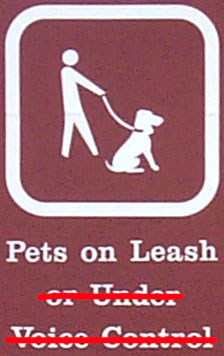 |
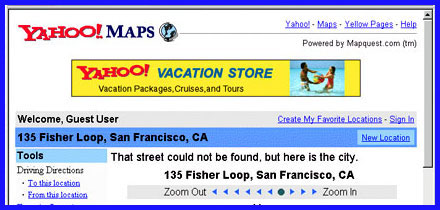
Secret Location, Secret Meeting?
The
GGNRA's Advisory
Commission web page begins by announcing that its meetings are, "Open
and accessible public meetings, where the public has an opportunity to comment
on park-related issues... " Just how accessible is a meeting
held at this obscure Presidio address: "135 Fisher Loop", and
without providing any directions or map? Type in the address
in Yahoo!Maps and it can't find the location! It took about a half
hour of intensive Web research to figure out where this building is!
Commissioner
Edgar Wayburn: "On
the other hand, we have not had any advance notice of this, and being confronted
by several resolutions, which we have not seen, I think is not wise of this
commission.
Commissioner
Doug Nadeau:
Send a letter, postcard or e-mail
|
|
Addresses for Letters, Postcards
& E-Mails
|
The
Hon. Nancy Pelosi, |
The
Hon. Tom Lantos |
The
Hon. Barbara Boxer |
|
The
Hon. Dianne Feinstein, |
Kevin
Shelley, Majority Leader |
Jackie
Speier, State Senator |
|
Supervisor
Tom Ammiano, |
Supervisor
Chris Daly, |
Supervisor
Matt Gonzalez, |
|
Supervisor
Tony Hall, |
Supervisor
Mark Leno, |
Supervisor
Sophie Maxwell, |
|
Supervisor
Jake McGoldrick, |
Supervisor
Gavin Newsom, |
Supervisor
Aaron Peskin, |
|
Supervisor
Gerardo Sandoval, |
Supervisor
Leland Yee, |
Willie
L. Brown, Jr., Mayor |
|
Gale
Norton, |
Brian
O’Neill, Superintendent |
|
|
Mr.
Michael Alexander |
Ms.
Susan Giacomini Allan |
Mr.
Richard Bartke, Chair |
|
Mr.
Gordon Bennett |
Ms.
Anna-Marie Booth |
Ms.
Betsey Cutler |
|
Mr.
Redmond Kernan |
Mr.
Mel Lane |
Ms.
Yvonne Lee |
|
Ms.
Amy Meyer, Vice Chair |
Mr.
Doug Nadeau |
Mr.
Trent Orr |
|
Ms.
Lennie Roberts |
Mr.
Dennis J. Rodoni |
Mr.
Fred Rodriguez |
|
Mr.
Douglas Sidon |
Mr.
John Spring |
Dr.
Edgar Wayburn |
|
Fort Funston Closure Update ...... Write O'Neill Again! Many people have asked what might be done about the Park Service's failure to fairly respond to the issues raised in the public comment submissions. If you believe that the Park Service decision did not address a particular issue raised in your comment letter, you can: Send GGNRA Superintendent Brian O'Neill another copy of your letter, circle the specific portion that concerns what you feel was not fully considered, and ask for three things:
. Please send a cc to SFDOG or Fort Funston Dog Walkers at the following addresses.
|
Signs
Go Up: Park Service Ignores Federal Court Order Once Again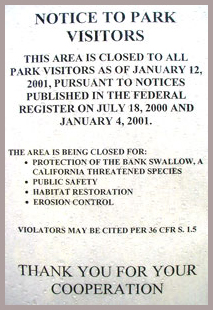
In January, the National Park Service posted signs along the fences at Fort Funston announcing that the area would be closed on January 12th. However, that would defy last year's U.S. District Court preliminary injunction, which specifically requires that the Park Service apply to the Court asking for the injunction to be lifted, even if it has completed the required rulemaking process..
What is it with the Park Service? They had to be forced last August via a contempt of court motion to obey the court order and open the area after the bank swallows left (see: National Park Service Blows Off Federal Court Order to Open Gates -- Contempt of Court Motion Filed ). The agency seems to hold the federal court system in as much contempt as it does the public.
After receipt of a letter challenging this action, the Park Service once again decided to belatedly obey the federal court order. The area will not be closed on the 12th; the Park Service will now follow proper procedures and will likely ask the Court to lift the injunction later this month. The signs have been changed; now they announce a future closure but decline to state a date.
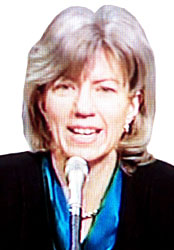 Gale
Norton Stresses Involving Those Affected in Decision-Making
Gale
Norton Stresses Involving Those Affected in Decision-Making
Interior Secretary Nominee Gale Norton testified in confirmation hearings before the Senate Committee on Energy and Natural Resources . The committee, and the full Senate, have confirmed Ms. Norton as Secretary of the Interior. An excerpt:
Senator Byron Dorgan (D-North Dakota): In what areas would you seek to be very different than the current Secretary on issues at Interior... I think my colleague from New Mexico said, 'you know, I'd like to, I hope you're different in a range of areas'; I hope you'll be very aggressive in a range of areas, in a significantly different way. Can you describe to us how you view your role as a new Secretary of Interior, if you are confirmed, and how -- as it compares to what you've seen happening in Interior in the last eight years?
Gale Norton, Interior Secretary Nominee: I plan to move into the Department of the Interior, if I am confirmed, and really learn about all the different issues and the things that have been done. I know that what's reported in the press is often quite different from the real scientific basis for a decision, or the statutory basis for a decision, so I would be looking across the board at those things that have been done in the past, to evaluate those things.
I would see one primary difference in my desire to involve the people who are most impacted by decisions, in making those decisions. Certainly in the western United States there has been a large concern that their voices have not been heard -- that the current Secretary of the Interior has not listened, has not sought to provide the input that those in the West would like to have. I would like to be sure that when we make decisions, we are making those with the input from all of those who are affected -- with the voices of ranchers, with the voices of environmentalists, with the voices of everyone who is concerned about those decisions heard as a part of the process.
In Colorado, we have some ranchers that I know, who went through a process of trying to decide how their mountain valley was to be managed for the long term future, and it involved public lands and private lands; it's a beautiful mountain valley, and it's near the Crested Butte ski area. That process is one that started with the environmentalists and the ranchers very much at odds. They were able to sit down together and find common ground, to realize that no one wanted the entire valley to be ski condos, that people wanted to see those scenic vistas preserved. By working together, they were able to come up with solutions.
Now, if Washington DC had been the decision-making place, without the people who directly knew that land making those decisions, I don't think we would see the kind of cooperative working relationship that eventually came forward. That's the type of decision-making that I would like to foster.
Chairman (until next week) Jeff Bingaman (D-New Mexico): Senator Thomas.
Sen. Craig Thomas (R-Wyoming): Thank you, Mr. Chairman. Welcome back again, Gale. I want to pursue this just a little further. I think one of the difficulties that we've had, certainly, is having input that -- that mattered. I was recently at a meeting with Secretary Babbitt. He mentioned in his talk ten times "partnerships" -- well, the experience we've had with partnerships is kind of one horse and one dog, kind of that relationship.
I'd like to hear you talk a little bit about the cooperating agencies; we started that last year, which was a specific way of states and adjoining counties being involved. We've had experiences of going through the NEPA [National Environmental Policy Act] process, and then having the Secretary or an Assistant Secretary come out at the end of it, and put out a different proposal altogether. So, how could we strengthen this idea? I understand, in federal lands, that the federal government has responsibility for the final decision. But, if we're going to talk about partnerships, if we're going to talk about cooperating agencies, maybe you could -- I guess you've expressed yourself -- but how could we sort of insure that there is a legitimate input into those kinds of proposed partnerships?
Gale Norton, Interior Secretary Nominee: If I am confirmed as Secretary of the Interior, I plan to work with the Western governors, with the attorneys general whom I know as personal friends, with the officials on a state basis and a local basis, to begin a process of involving them. From them, we need to move out to the private sector groups that are also to be impacted by our decisions, and to begin, on a case-by-case basis, as we see important decisions arising, finding appropriate ways of inviting everyone who would be affected to have an input into that process.
It's going to be a continuing dialogue. You know best in your state, who are the people that are really going to be impacted by something, and, looking to your guidance in finding those who should be involved in a particular decision, would be the kinds of feedback that I would hope to get.
And that applies on a bipartisan basis. I think each of you know and understand your own state, and each of you has an appropriate role in expressing to federal agencies what your concerns are. And I would hope to have that sort of input from both sides of this table.
 Swallows,
Lies & Vindictiveness
Swallows,
Lies & Vindictiveness
-
"This year-round closure of just 12 acres is necessary"
-
"protects bank swallows"
- "controls erosion"
- "promotes biodiversity through native plants"
- "increases public safety in cliff areas"
INSTRUCTIONS:
Repeat above
ad nauseam without regard to scientific basis, founding
vision, or common sense.
Gloss over 1100 objections, while expanding closure in retaliation for protest and lawsuit.
On Monday, Dec. 18th, 2000 the National Park Service announced that it will go ahead with its proposed closure of 12 acres at Fort Funston.
Click here to visit their website and review the documents related to the proposal and decision. Gee! They actually published the entire closure proposal itself on their own website yesterday, a mere five months after it was published here on Fort Funston Forum -- and safely long past the end of public comment on the proposal.
So, the plan is to grab another two acres, all the way to the beach access trail, in addition to the ten acres that were closed earlier this year. The same acres that were then opened with a federal court order forcing the Park Service to follow the letter -- if not the spirit -- of the law. They published their plans and pretended to listen to the groundswell of public comment that many people diligently prepared. They had their sham "Citizens' Advisory Commission" (aka "The Rubberstampers") provide cover and the appearance of oversight where there is none. Now they expect to seal the area in January, once they've published their plans in the Federal Register.
You can be sure that it ain't over yet! Numerous options remain and will be explored. With a new Board of Supervisors, a new Secretary of the Interior, and a whole lot of outraged citizens, "closure" may not be as easy or as consequence-free as may have been assumed by the Superintendent.
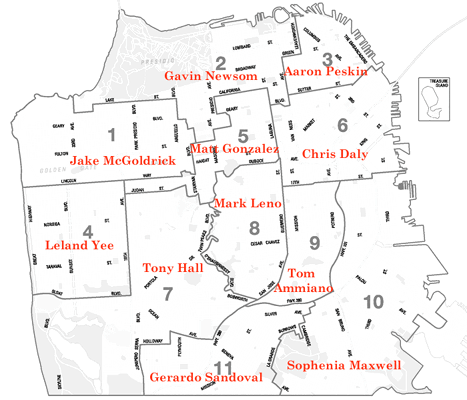 |
Voters tossed aside the status quo in December, opting for a new board of supervisors, two-thirds of whom are new members, and most of whom are independent of the powers-that-be. Off-leash dog recreation was an issue. People involved in this fight were active in various campaigns, particularly in Leland Yee's successful bid for re-election in District 4. Let's let our incoming supes know about our need for help in the fight to protect our right to off-leash recreation in city parks as well as the GGNRA. |
CLICK HERE
for GGNRA's Draft Minutes
of Nov. 28th Citizens' Advisory Commission Meeting
of Nov. 28th Citizens' Advisory Commission Meeting
CLICK HERE for verbatim TRANSCRIPT
of Nov. 28th GGNRA ADVISORY COMMISSION MEETING
|
There has been much confusion about the Advisory Commission's "recommendation", which it seems may just be a rubber stamp for a planned management action. It appears that the plan would be this: The fences come down, and dogs are banned from the 12 acres, except for one trail (not sure where this would run), and they must be leashed on that trail. But all this pales in comparison to the remarkably devious attempt by Vice Chair Amy Meyer and others to push through a change in a twenty one year old pet policy without any notice or the bother of going through the cumbersome democratic process of placing it on the agenda. This brazen attempt to establish a fait accompli failed and the motion was tabled for now. But watch for more developments soon. |
Advisory Commission Says Close Area to Off-Leash Dogs;
Stealth Motion to Rescind Off-Leash Pet Policy Ruled Out of Order
The GGNRA's Citizens Advisory
Commission Tuesday night, Nov. 28, 2000, approved a resolution supporting
the closure proposal, after a remarkably brief and cursory discussion
of an issue that raised 1500 comments. The next step is for the Superintendent
to issue a decision, which is expected in December.
The resolution ended... "Now
therefore be it resolved that the decision of the GGNRA Superintendent
to close twelve acres of Fort Funston to dogs is appropriate and necessary,
and be it further resolved that in preference to permanent closure, the
Commission requests the Superintendent consider removing the fences and
having a trail through the area accessible to dogs on a leash."
There was no discussion whatsoever
of the crux of the issue: the lack of scientific evidence that the closure
is needed to accomplish environmental or other concerns. Instead, the
whole discussion revolved around dogs. The proposal supposedly
wasn't about dogs, we were told repeatedly -- this was a closure to everybody.
Yet that aspect wasn't even mentioned in the comments.
Further, and quite shockingly,
Vice Chair Amy Meyer then went on to introduce a motion which was not
on the agenda at all: to rescind the commission's 1979
Pet Policy. (That policy permitted off-leash recreation in certain
areas of the GGNRA in accordance with long-standing practice and the park's
enabling legislation).
There was a concerted effort
to ramrod this motion through, but thankfully commission member Redmond
Kernan pointed out right away that the motion wasn't even on the agenda.
Even so, several members went on to opine in favor of voting on it, anyway!
One member, Trent Orr, even commented sarcastically that he supposed someone
could go to federal court over the motion not having been properly "noticed"
-- but that he was in favor of proceeding! A member worried about the
legal ramifications of passing such a stealth motion without proper notice.
Two audience members spoke as a "point of order" about the lack
of notice and opportunity for public comment or opposing legal opinions.
The motion was indeed introduced,
but the commission was on notice of the stealth tactic; Bartke ruled it
out of order for not being on the agenda.
Amy Meyer was particularly
emphatic in pushing for the motion. Ironically, she used as her reasoning
the fact that this has been "a 20 year policy" and yet she insisted
on pursuing a stealth motion to revoke it without so much as following
the legal mandate of the commission to announce in advance agenda items
so that the public can participate in the process.
Once again, the science
and the process, the law and the very mission of the GGNRA are being violated
by the those who are supposed to be a citizens' oversight body.
The motion will be "calendared"
for a future meeting, at the earliest the end of January as there is no
meeting in December.
Fasten your seatbelts, we
are in for a rough ride! The issue at stake is off-leash rights throughout
the GGNRA, and we need to be sure to let the agency know exactly what
they would be facing were they to start ticketing people for walking their
dogs off-leash.
-
Michael B. Goldstein, Editor
GGNRA WatchDog
Table
of Contents
|
Welcome to My Website |
|
Fence Protest
Photos -- March 4th, 2000 |
|
Court Report |
|
Court orders gates stay open short of "emergency" |
|
Reply
Brief Highlights |
|
"The
Park Service has made a complete end-run |
|
Motion for
Contempt due to Park Service's Initial
Refusal to |
|
Into the Promised
Land! |
|
Proposed Closure
at Fort Funston |
|
Poor Notice
Park
Service's limited, late & inconspicuous |
|
GGNRA Advisory Commission Meeting |
|
GGNRA Advisory Commission |
|
Controversy
at Fort Funston |
|
Action Alert |
|
What's Happening
at Fort Funston |
|
Fort
Funston in Jeopardy |
|
Addresses |
|
Sample Letters &
Petition |
|
Clean-Up Days at Fort
Funston |
|
Letter to
City Officials from Lydia Boesch |
|
Board of Supervisors'
Hearings on Fort Funston |
|
SF SPCA |
|
Crissy Field
... Crissy Heeled? |
|
Two More Acres
- photo
of extra two acres |
|
"Closure
Creep" Animated Map |
|
Spurious Trail Closure |
|
Rotating Closure
Signs & Reasons |
|
Initial
Bank Swallow Closure Sign |
|
They're Back! |
|
Gate Accompli |
|
Fort Fenced-In |
|
Rudy's Walk |
|
Where's the
Science? |
|
The Non-Empirical's New Close |
|
The Bureau that
Cried Wolf |
|
Park Service
Mourns Crash Victims |
|
Bluff Failures on the Sunset Trail |
|
My Heart is
Broken |
|
An Enchanting
Walk with Scout |
|
Dancing
with Bank Swallows: A Bird Dog's Tale |
|
Some Thoughts
on Fort Funston |
|
Closed.
Permanently. Thoughts
on a stolen treasure. |
|
When
Does the Past Begin? |
|
Golden Gate
Park's Transformation |
|
"Don't Fence Us
Out!" Song |
|
On November 6th the Board of Supervisors unanimously passed Supervisor Leland Yee's resolution, requesting that the City Attorney contact the Park Service and request accountability for "past and proposed closures" at Fort Funston in relation to the agreement made between the City and the federal government when the land was transferred. See full text of the resolution below. |
|
Full
Transcripts of Hearings on Fort Funston |
|
Letter
to Congress
|
November 1, 2000 525 Market Street, Suite 3670 450 Golden Gate Avenue, 14th floor San Francisco, CA 94105 San Francisco, CA 94102 1700 Montgomery Street, Suite 240 400 South El Camino Real, Suite 410 San Francisco, CA 94111 San Mateo, CA 94402 RESOLVED, That the Board of Supervisors of the City and County of
San Francisco hereby urges San Francisco's Congressional delegation,
including Representatives Nancy Pelosi and Tom Lantos and Senators
Barbara Boxer and Dianne Feinstein, to investigate the Golden
Gate National Recreation Area's handling of the Fort Funston closures
and to take action to preserve recreational areas for San Franciscans
. . . The full text of Supervisor Teng=s resolution may be found at www.fortfunstonforum.com, in addition
to a subsequent resolution regarding Fort Funston introduced by
Supervisor Leland Yee. |
San
Francisco Board of Supervisors Pass
|
|
Yee
Resolution |
[Urging the National Park Service to provide an explanation of Fort Funston Closures]Resolution requesting the City Attorney contact the National Park Service reminding the National Park Service of its obligation to submit its construction plans to the City for review, seeking an explanation of how the past and proposed closures serve a recreation or park purpose and inquiring how the National Park Service will provide disability access in light of its removal of a paved path. WHEREAS, In 1975, the City and County of San Francisco transferred Fort Funston and other City-owned park lands to the federal government to be included in the Golden Gate National Recreation Area (GGNRA), to be administered by the National Park Service (NPS); and WHEREAS, The statute creating the GGNRA (16 U.S.C. Section 460bb) specifically states that the GGNRA was established to provide for the maintenance of needed recreational open space necessary to the urban environment and planning and requires that the Secretary of the Interior "utilize the resources in a manner which will provide for recreation and educational opportunities consistent with sound principles of land use planning and management;" and WHEREAS, Former Charter section 7.403-1(a), as approved by the voters, required that the deed transferring any City-owned park lands to the NPS include the restriction that said lands were to be reserved by the Park Service "in perpetuity for recreation or park purposes with a right of reversion upon breach of said restriction;" and WHEREAS, The deed transferring these City-owned park lands to the NPS contains the following restriction: "to hold only for so long as said real property is reserved and used for recreation and park purposes; and WHEREAS, A contemporaneous agreement ("Agreement") concerning the rights and duties of the parties requires the NPS, among other things, to submit its plans for construction on the park lands or changes in the natural environment of these properties to the City's Planning Department for review and comment in order to ensure that the Department of City Planning will be informed and involved during all stages of the planning process and in particular during the conceptual planning stage where potential conflicts can be resolved prior to the development of specific plans; and WHEREAS, The City Attorney has concluded that the City and County of San Francisco has a right to bring legal action against the NPS in the event the NPS breaches the deed restriction and agreement; and WHEREAS, Since 1991, the NPS has closed heavily-used portions of Fort Funston for the avowed purpose of habitat protection and native plant restoration, thereby precluding any recreational use, without notifying the City and County of San Francisco; and WHEREAS, The NPS now proposes permanent closure of an additional twelve acres of prime recreation space at Fort Funston, without notifying the City and County of San Francisco; now, therefore, be it RESOLVED, That Board of Supervisors of the City and County of San Francisco requests that the City Attorney write to the NPS reminding the NPS of its duty to submit to the San Francisco Planning Department for review, comment, and approval plans for construction at Fort Funston, including plans to install or maintain fencing at Fort Funston which precludes recreational use by park visitors; and, be it FURTHER RESOLVED, That the Board of Supervisors requests the City Attorney to write to the NPS to ask them to provide access to people with disabilities and to explain their plans for resurfacing the previously paved Sunset Trail; and, be it FURTHER RESOLVED, That the Board of Supervisors of the City and County of San Francisco hereby requests the City Attorney write a letter to the NPS requesting the NPS to explain how the closures that have been effected at Fort Funston since 1991, including the proposed twelve-acre closure, comply with the deed restriction requiring that Fort Funston be used only for recreation or park purposes. Leland Y. Yee, Ph.D. BOARD OF SUPERVISORS 10/30/00 |
|
Teng
Resolution
-- approved by S.F. Board of Supervisors, Mon. Oct. 30, 2000: |
[Urging Congressional Action on Fort Funston]:Resolution urging San Francisco's Congressional delegation, including Representatives Nancy Pelosi and Tom Lantos, and Senators Barbara Boxer and Dianne Feinstein, to investigate the Golden Gate National Recreation Area's handling of the Fort Funston closures and to take action to preserve recreational areas for San Franciscans. WHEREAS, Fort Funston is a unique and beloved recreational park enjoyed by neighbors, dog owners and residents throughout the San Francisco Bay Area; and, WHEREAS, In addition to acres of hiking trails, beaches, ocean view bluffs, and plant and bird habitats, Fort Funston is also [one of] the largest off-leash areas for dogs and their owners; and, WHEREAS, Earlier this year, 10 acres of Fort Funston were closed to park users by the Golden Gate National Recreation Area (GGNRA), which has authority over Fort Funston; and, WHEREAS, The GGNRA initiated the closures, purportedly to protect the endangered bank swallows, without justifying the need for such extensive closures, without notifying the City and County of San Francisco, and without the requisite public notice and hearings; and, WHEREAS, In April 2000, a U.S. District Court judge ruled that the National Park Service violated its own rules in unlawfully fencing off 10 acres without public hearings in a manner showing "an intent... to railroad through the closure, to maintain secrecy, to unleash the fencing with lightning speed."; and, WHEREAS, Subsequent to the court ruling, the GGNRA opened up a comment process, then returned with a more restrictive plan of closing 12 acres rather than 10 acres and permanently rather than seasonally; and, WHEREAS, The GGNRA is a part of the National Park Service which is a branch of the federal Department of Interior; now, therefore, be it RESOLVED, That the Board of Supervisors of the City and County of San Francisco hereby urges San Francisco's Congressional delegation, including Representatives Nancy Pelosi and Tom Lantos and Senators Barbara Boxer and Dianne Feinstein, to investigate the Golden Gate National Recreation Area's handling of the Fort Funston closures and to take action to preserve recreational areas for San Franciscans; and be it FURTHER RESOLVED, That a copy of this resolution be forwarded to his Honor, the Mayor, with a request that he transmit copies to the members of Congress from San Francisco and the United States Senators from California. - Supervisor Mabel Teng, Board of Supervisors 10/23/00 |
|
City Attorney Announces Review of Fort Funston Issue The San Francisco City Attorney has given an opinion on the issue of the City's rights with respect to the closures at Fort Funston to Supervisor Leland Yee's Labor and Finance Committee.(The enabling legislation turning the park over to the Park Service from The City specified that all then-existing recreation - - which included off-leash dog walking - - was to continue, and that the City had a reversionary right to take the park back if the federal government did not maintain this use.) While the report says the National Park Service may close areas in the name of the environment, it also points out that The City could sue to reclaim the land if the Park Service's decision was "arbitrary and capricious". |
